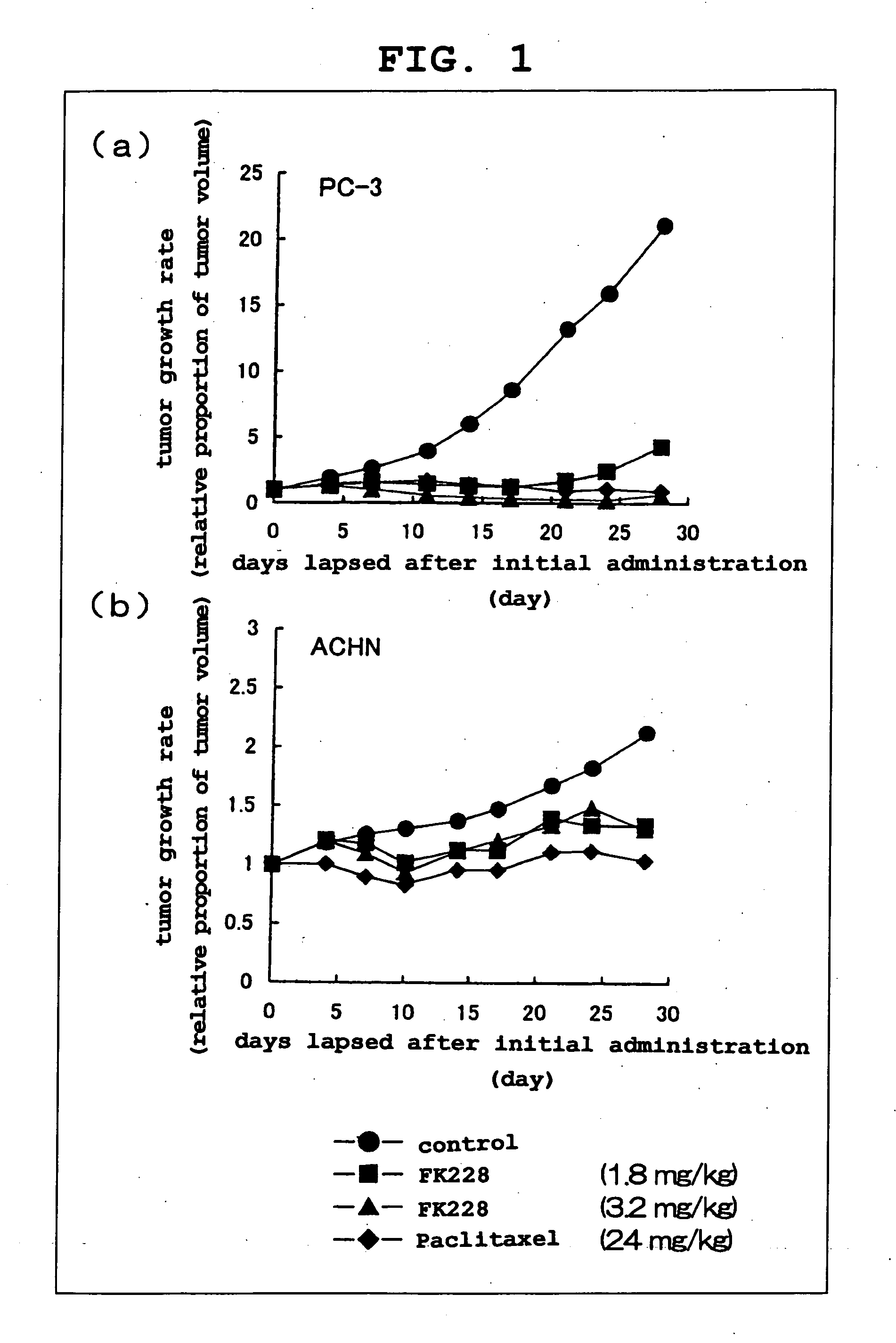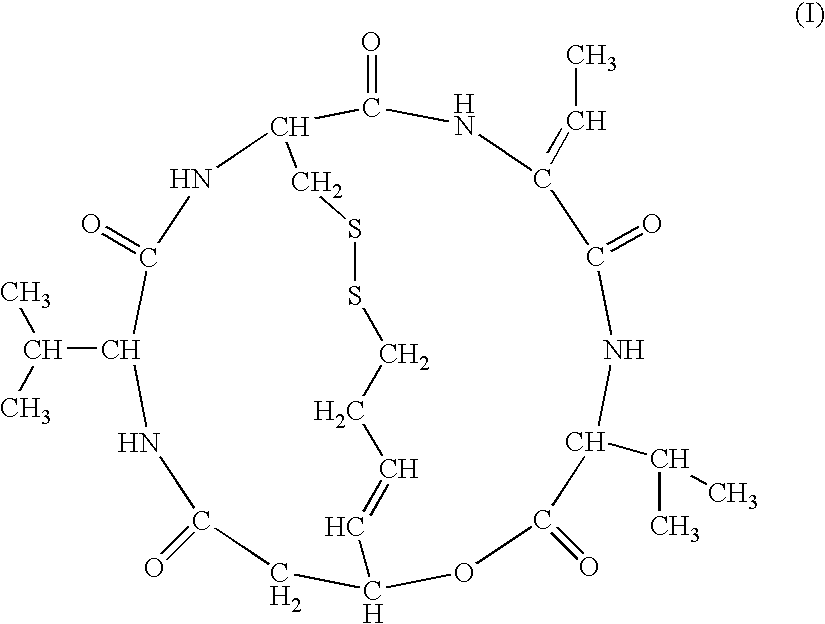Method of Estimating Antitumor Effect of Histone Deacetylase Inhibitor
a technology of histone deacetylase and antitumor effect, which is applied in the field of method of estimating the antitumor effect of histone deacetylase inhibitor, can solve the problems of many problems that are yet to be solved
- Summary
- Abstract
- Description
- Claims
- Application Information
AI Technical Summary
Benefits of technology
Problems solved by technology
Method used
Image
Examples
example 1
Evaluation of Compound A Sensitive Tumor and Compound A Resistant Tumor
(1) Preparation of Pharmaceutical Agent
[0044] A necessary amount of FK228 was weighed and a solvent (10% HCO-60 / saline) was added. The mixture was sonicated to allow for dissolution. A positive control substance Paclitaxel was dissolved in Cremophor EL / ethanol (1:1) solution to 24 mg / mL prior to the testing, and preserved in a refrigerator. When in use, it was diluted with a 9-fold amount of physiological saline to 2.4 mg / mL (solvent component: 5% Cremophor EL-5% ethanol-90% saline).
(2) Test Animal
[0045] For antitumor test of the pharmaceutical agent, BALB / cANnNCrj-nu / nu mice (male, 6-week-old) were purchased from Charles River Japan and, after acclimation for not less than one week, used for the test. The mice were reared under an SPF environment and allowed a free access to water and feed.
(3) Test Tumor
[0046] Cultured human kidney cancer cell line 1 (ACHN: available from ATCC) and human culture prostat...
example 2
Evaluation of Compound A Sensitive Tumor and Compound A Resistant Tumor
(1) Test Material
drug: compound A (FK228)
[0052] dose: 3.2 mg / kg
[0053] administration volume: 10 mL / kg
[0054] solvent: 10% HCO-60 / saline solution
[0055] dosage form: solution (prepared when in use)
tumor cell: human prostate cancer PC-3 (tumor fragment 3 mm×3 mm×3 mm / mouse implantation site s.c.)
[0056] human gastric cancer SC-6; obtained from Central Institute for Experimental Animals (tumor fragment 3 mm×3 mm×3 mm / mouse implantation site s.c.)
[0057] human kidney cancer ACHN (tumor fragment 3 mm×3 mm×3 mm / mouse implantation site s.c.)
[0058] human kidney cancer A498; obtained from ATCC (tumor fragment 3 mm×3 mm×3 mm / mouse implantation site s.c.)
[0059] Subcultured animal: male BALB c / nu / nu
(2) Procedure and Results
[0060] By the method shown in Example 1, 3 mm square tumor fragments (human prostate cancer PC-3, human stomach cancer SC-6, human kidney cancer ACHN and human kidney cancer A498) were subcuta...
example 3
Analysis of Gene Expression Pattern of Compound A Sensitive Tumor and Compound A Resistant Tumor Using Gene Chip
[0061] The gene expression pattern of the tumor for which sensitivity and resistivity were confirmed in Example 2 was examined.
(1) Test Material
tumor cell human prostate cancer PC-3 (tumor fragment 3 mm×3 mm×3 mm / mouse implantation site s.c.)
[0062] human gastric cancer SC-6; obtained from Central Institute for Experimental Animals (tumor fragment 3 mm×3 mm×3 mm / mouse implantation site s.c.)
[0063] human kidney cancer ACHN (tumor fragment 3 mm×3 mm×3 mm / mouse implantation site s.c.)
[0064] human kidney cancer A498; obtained from ATCC (tumor fragment 3 mm×3 mm×3 mm / mouse implantation site s.c.) Subcultured animal: male BALB c / nu / nu
RNA extraction: RNeasy Mini Kit (50) (Qiagen)
[0065] RNase, DNase free water (Life Technologies)
DNA synthesis: Superscript Choice System (Life Technologies) [0066] Ethachinmate (Nippon gene) [0067] T7-(dT)24 Primer (Amersham Pharmacia)
c...
PUM
 Login to View More
Login to View More Abstract
Description
Claims
Application Information
 Login to View More
Login to View More - R&D
- Intellectual Property
- Life Sciences
- Materials
- Tech Scout
- Unparalleled Data Quality
- Higher Quality Content
- 60% Fewer Hallucinations
Browse by: Latest US Patents, China's latest patents, Technical Efficacy Thesaurus, Application Domain, Technology Topic, Popular Technical Reports.
© 2025 PatSnap. All rights reserved.Legal|Privacy policy|Modern Slavery Act Transparency Statement|Sitemap|About US| Contact US: help@patsnap.com



